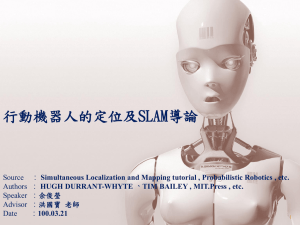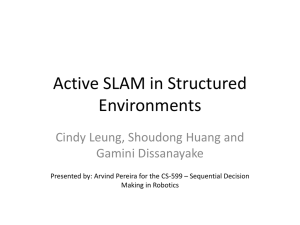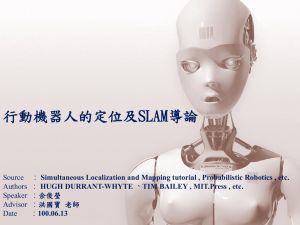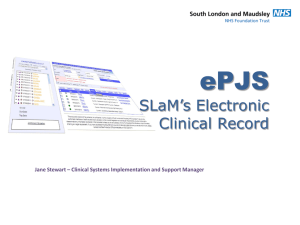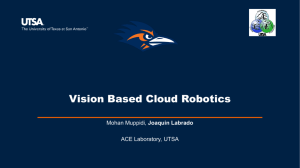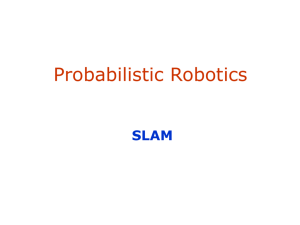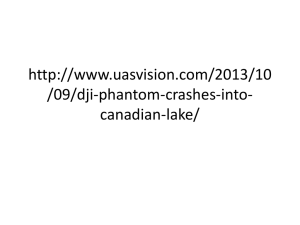Document 13136179
advertisement
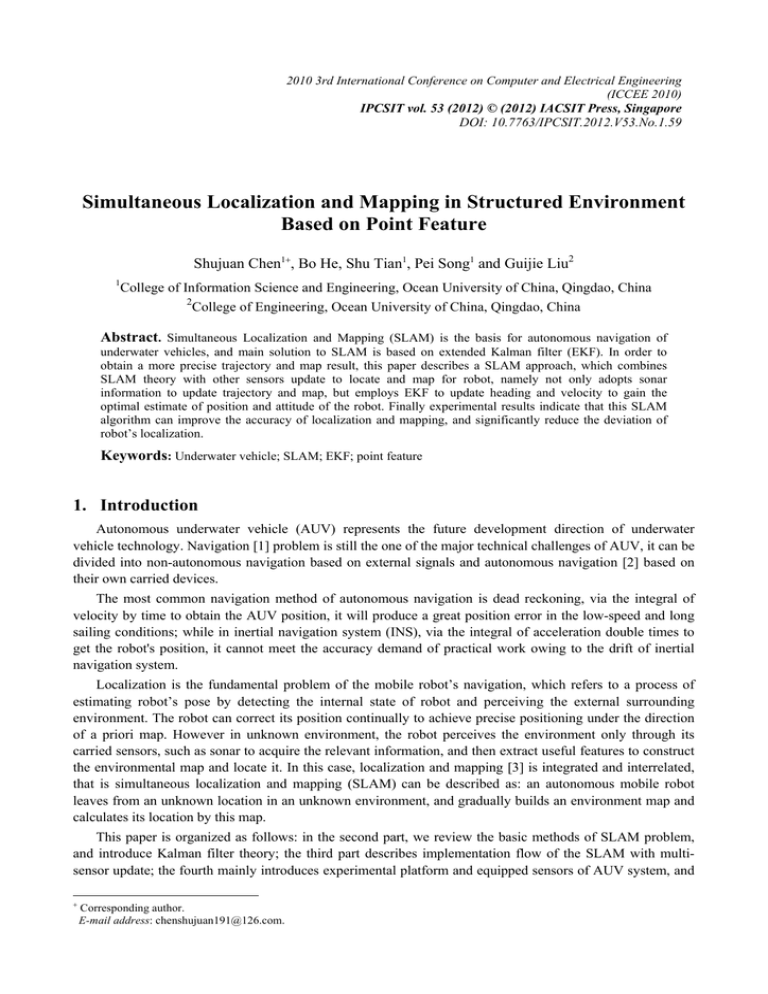
2010 3rd International Conference on Computer and Electrical Engineering (ICCEE 2010) IPCSIT vol. 53 (2012) © (2012) IACSIT Press, Singapore DOI: 10.7763/IPCSIT.2012.V53.No.1.59 Simultaneous Localization and Mapping in Structured Environment Based on Point Feature Shujuan Chen1+, Bo He, Shu Tian1, Pei Song1 and Guijie Liu2 1 College of Information Science and Engineering, Ocean University of China, Qingdao, China 2 College of Engineering, Ocean University of China, Qingdao, China Abstract. Simultaneous Localization and Mapping (SLAM) is the basis for autonomous navigation of underwater vehicles, and main solution to SLAM is based on extended Kalman filter (EKF). In order to obtain a more precise trajectory and map result, this paper describes a SLAM approach, which combines SLAM theory with other sensors update to locate and map for robot, namely not only adopts sonar information to update trajectory and map, but employs EKF to update heading and velocity to gain the optimal estimate of position and attitude of the robot. Finally experimental results indicate that this SLAM algorithm can improve the accuracy of localization and mapping, and significantly reduce the deviation of robot’s localization. Keywords: Underwater vehicle; SLAM; EKF; point feature 1. Introduction Autonomous underwater vehicle (AUV) represents the future development direction of underwater vehicle technology. Navigation [1] problem is still the one of the major technical challenges of AUV, it can be divided into non-autonomous navigation based on external signals and autonomous navigation [2] based on their own carried devices. The most common navigation method of autonomous navigation is dead reckoning, via the integral of velocity by time to obtain the AUV position, it will produce a great position error in the low-speed and long sailing conditions; while in inertial navigation system (INS), via the integral of acceleration double times to get the robot's position, it cannot meet the accuracy demand of practical work owing to the drift of inertial navigation system. Localization is the fundamental problem of the mobile robot’s navigation, which refers to a process of estimating robot’s pose by detecting the internal state of robot and perceiving the external surrounding environment. The robot can correct its position continually to achieve precise positioning under the direction of a priori map. However in unknown environment, the robot perceives the environment only through its carried sensors, such as sonar to acquire the relevant information, and then extract useful features to construct the environmental map and locate it. In this case, localization and mapping [3] is integrated and interrelated, that is simultaneous localization and mapping (SLAM) can be described as: an autonomous mobile robot leaves from an unknown location in an unknown environment, and gradually builds an environment map and calculates its location by this map. This paper is organized as follows: in the second part, we review the basic methods of SLAM problem, and introduce Kalman filter theory; the third part describes implementation flow of the SLAM with multisensor update; the fourth mainly introduces experimental platform and equipped sensors of AUV system, and + Corresponding author. E-mail address: chenshujuan191@126.com. compares trajectory results of SLAM algorithms. The last two parts are conclusion of this paper and acknowledgement. 2. SLAM Theory 2.1 Solutions to the SLAM problem SLAM is the research focus in the field of mobile robot navigation, and is the real key to autonomous mobile robots. One of the main difficulties of the SLAM problem is to overcome the strong coupling between mapping and localization estimation. Without a reliable environmental map, the robot can not accurately determine its location; similarly, without a precise position, it’s also difficult to create an environmental map exactly. Currently, popular methods of SLAM are: (1) SLAM based on EKF [4], it can be summarized as a process of estimate and correction iteration, divided into prediction, observation and update phases, employs movement and observation model to predict the robot's next location and environmental characteristics which may be observed, then calculates error between the actual observation and estimated observation, through Kalman filter parameters and covariance of integrated system to correct the previous estimated robot position, and augments new observations into the environmental features map. Mobile robot corrects the estimates in motion process continually, eliminates the accumulated error to get location information as accurately as possible, and ensure the successful completion of navigation. (2) SLAM based on probability, although it is less popular than EKF based SLAM, but very natural and reasonable to describe robot’s location uncertainty in terms of probability. The greatest similarity estimation α − β algorithm is a very effective method, mapping and localization of the robot can be considered as the maximum similarity estimation of a robot location and environmental characteristics. Compared with EKF based SLAM, it bypasses accuracy dependence of observation association with map features, improves the convergence of the algorithm. However, the processed data of this approach is so much that the computing speed and storage requirements of the computer are very high, restricting application to the large-scale environment. (3) SLAM based on particle filter [5], the idea of this algorithm is to adopt a filter to estimate the robot's possible location (probability of location), and each filter corresponds with a position, through the observation to transfer the each filter’s weight, so that the probability of most likely location gets high. But an important premise of SLAM based on particle filter is that the observed environmental characteristics only rely on the current location of the robot. 2.2 Kalman filter Kalman filter [6] is the most optimal regression data processing algorithm, an optimal solution to most of the problems, widely used in robot navigation, sensor data fusion and missile tracking. It is a state-space information fusion algorithm, applied in linear state transitions and state observation, where the corresponding noise error is Gaussian distribution. Performance cycle of EKF is two-step basically, prediction and update. By recursion to obtain the minimum mean square error of the state estimation. However, in most practical systems, system and observation equations are almost nonlinear. For nonlinear systems, common Kalman filter can not meet the system’s demand, in order to solve the nonlinear estimation problems, proposing an Extend Kalman filter (EKF) method. EKF is the Kalman filter applied to the nonlinear systems. 3. Implementation of SLAM The AUV system’s state equations are generally nonlinear in actual environment, therefore EKF theory is adopted. To make the robot have a better localization and mapping [7] in unknown environment, we introduce heading and velocity update in simply based on sonar update SLAM [8]. Robot's state variables include five components, the first two are position of x, y direction, third is robot's heading, and the last two are velocity of x, y direction. Implementation flow of SLAM with multi-sensor is as follows: Figure 1. Implementation flow of SLAM 3.1 Robot’s state initialization The system adopts heading and velocity update, so they are considered as state variables, while the angular velocity and acceleration are viewed as controlled variables. Robot’s initial state and covariance matrix [9] are represented as: X = X v = ⎡⎣ x y θ vx v y ⎤⎦ T (1) P ( 0 ) = Pv ( 0 ) = [ 0 5*5 ] (2) Where X ( 0) = X v (0 ) = [0 5*1 ] , X v represents the robot’s pose, x, y, vx and v y are the position and velocity of x, y direction respectively, and θ is heading. 3.2 Prediction based on EKF theory Collect heading and velocity data from sensors to predict the next state of robot, which is called dead reckoning. State and covariance matrix prediction are: X v ( k + 1) = f ( X ( k ), U( k )) (3) 2 /2)cos(θ) −(vyT +ayT2 /2)sin(θ)⎤ ⎡ x ⎤ ⎡x(k) +(vT x +aT x ⎥ ⎢ ⎥ ⎢ 2 /2)sin(θ) +(vyT +ayT2 /2)cos(θ)⎥ x +aT x ⎢ y ⎥ ⎢y(k) +(vT ⎥ θ(k) +wT Xv−(k +1) = ⎢θ ⎥ = ⎢ n ⎥ ⎢ ⎥ ⎢ vx(k) +aT ⎥ ⎢vx ⎥ ⎢ x ⎥ ⎢v ⎥ ⎢ v ( k ) a T + y y ⎣ y⎦ ⎣ ⎦ (4) Pk−+1 = GPk G T + HQH T (5) T In which U (k ) = [wn ax ay ] represents controlled variables, corresponding noise matrix is Q. wn , ax and a y are the robot's angular velocity and acceleration of x, y direction, T denotes the prediction interval, G and H are Jacobian matrices of partial derivative of the non-linear model function with respect to the state Xv and the controlled variables U(k). 3.3 Velocity sensors’ observation and update Update heading and velocity data according to EKF theory. Observation measurement and matrix are: Z d = ⎡⎣θ vx v y ⎤⎦ T (6) ⎡ 0 0 1 0 0 0m ⎤ H d = ⎢⎢ 0 0 0 1 0 0m ⎥⎥ ⎢⎣0 0 0 0 1 0m ⎥⎦ vy vx Where θ denotes heading collected from the compass, and (7) are the velocity provided by the DVL. According to EKF theory, we get innovation, innovation matrix and Kalman gain: Vd = Z d − H d X (8) S d = H d P − H dT + Rd (9) Wd = P − H dT Sd −1 (10) X + = X − + WdVd (11) And updated state and covariance matrix are: P + = P − − Wd S dW Where T (12) represents measurement noise of the observation, supposed to be white Gaussian distribution. Rd 3.4 Data association The core of SLAM is localization and mapping, localization data are provided by speed sensors, while features in mapping can only rely on the sonar. As robot navigates in the sea, apart from individual's bank, the rest obstacles are scattered points, hence point features can be employed to represent the environmental map. Process the collected sonar data to extract the returned obstacles’ information as environmental features for SALM algorithm. To boost SLAM efficiency, point features are sparse, and the main idea of sparseness is to lessen the number of features grounded on the actual environmental features distribution in each scan period, remaining fewer features to improve the performance of SLAM. Observation and predicted observation are shown as: ⎡r ⎤ Zs = ⎢ s ⎥ ⎣θ s ⎦ (13) ⎡ ( x − x)2 + ( y i i ^ ⎢ − Z s = h( X ) = ⎢ ⎛ yi − y v arctan ⎜ ⎢ ⎝ xi − x v ⎣ − y)2 ⎤ ⎥ ⎥ ⎞ ⎟ −θ ⎥ ⎠ ⎦ Where ( xi , yi ) represents the existed features in map. Observation and innovation matrix are: Hs = ∂h |X = [ H1 01 H2 ∂X Δy Δx Δy ⎡ Δx ⎤ ⎢− d − d 0 0 ... 0 d d 0 ... 0⎥ ⎢ ⎥ Δx Δx −1 0 ... 0 Δy Δx 0 ... 0⎥ − 2 02 ] ⎢ 2 − 2 d d d2 ⎦⎥ = ⎣⎢ d ^ (14) (15) − Vs =Zs −Zs =Zs −hX ( ) (16) S s = H s P − H sT + Rs (17) ∂h ∂h | − | − H2 = ∂xv X ∂xmi X , , Δx = xi − xv , Δy = yi − yv , and Rs denotes sonar observation noise, supposed to be In which white Gaussian distribution. H1 = Sonar observations employ individual compatible(IC) principle [10] to associate with the features existed in map, −1 such as the nearest neighbor (NN) data association. Calculating Mahalanobis distance Dij = Vs S s Vs between the point features [11], where Vs and Ss denote the observations innovation and corresponding covariance. If the Mahalanobis distance is smaller than threshold value, considering that the observations associated with features in map, then update the map and trajectory, or else augment the map. 2 T (1) Update: update the robot's state and map by the associated point features. The corresponding formulas are as follows: Ws = P−H S s −1 T s X + = X − + WsVs + − P = P −Ws SsW (18) (19) T (20) (2) Augment: transform the point features outside the threshold into global coordinate, and then expand those into the map directly. State variables and covariance matrix are: ⎡X ⎤ X aug = ⎢ ⎥ ⎣Zs ⎦ Paug ⎡ Pv = ⎢⎢ PvmT ⎢⎣ 0 (21) Pvm Pm 0 0⎤ 0 ⎥⎥ R ⎥⎦ (22) Where represents the sonar observations which are not associated with the existed features in map, corresponding covariance is R. Transform the observations into global coordinate: ⎡ x ⎤ ⎡ x + rs cos(θ s + θ ) ⎤ gi ( Xv , Z s ) = ⎢ i ⎥ = ⎢ ⎥ ⎣ yi ⎦ ⎣ y + rs sin(θ s + θ ) ⎦ (23) Linear expansion: X ⎡ ⎤ X + = f i ( X aug ) = ⎢ ⎥ ⎣ gi ( X v , Z s ) ⎦ (24) P + = ∇ f X a u g Pa u g ∇ f XTa u g (25) ⎡ Pv ⎤ Pvm Pv∇gXT v ⎢ ⎥ P+ = ⎢ PvmT Pm PvmT ∇gXT v ⎥ ⎢ T T⎥ ⎢⎣∇gXv Pv ∇gXv Pvm ∇gXv Pv∇gXv + ∇gz Rs∇gz ⎥⎦ (26) Where ∇f x arg is Jacobian matrix of partial derivative of the model function with respect to the state Xv. 4. Experimental Platform and Result Analysis 4.1 Experimental platform The experimental platform is shown in Figure 1 which is designed to detect the marine environment ‘SeaRanger’ (C-Ranger) AUV, with two electronic modules, five underwater propulsions, two SeaKing DST dualfrequency digital mechanical scanning sonar (the large one is used to build the environmental map, while the small is for obstacle avoidance), and camera, NavQuest600 Micro Doppler Velocity Log (DVL), highperformance GPS receiver, digital compass HMR3000, gyro VG951, vertical gyro XW-VG7300 and depth sensor. Figure 2. Platform of C-Ranger AUV 4.2 Experimental results This paper’s data set comes from an about 35m wide 60m long lake experiment. All sensors are turned on, and sonar scanning limit and distance are set to be 120°and 50m, therefore it can scan the bank of lake. (1) Trajectory and map of SLAM algorithm are shown as Figure 3 and 4. The only difference between two Figures is that the above one just employs sonar data to update the map and trajectory, while the other one also employs heading and velocity information to update the vehicle’s state while updating with sonar. Figure 3. Trajectory of SLAM (only sonar update) Figure 4. Trajectory of SLAM (all sensors update) In Figures, the red dot indicates the robot's GPS trajectory, as a benchmark for comparing the result of SLAM algorithm, black cross represents dead reckoning trajectory which becomes divergence over the time, while blue star is SLAM trajectory that significantly improves divergent phenomena of the dead reckoning, but reverses in later time, makes the last section of trajectory imprecise in Figure 3, but SLAM trajectory in Figure 4 not only improves dead reckoning result, but converges to GPS trajectory ultimately. Red circle represents the landmarks which are predefined by GPS. Map is shown by blue dot around the trajectory which is the post processed landmark points, from which bank information can be seen clearly, and distribution matches the real environment. SLAM trajectory result mainly depends on the selection of various parameters of the algorithm, including angular velocity uncertainty, heading uncertainty, uncertainty of the two speeds, acceleration uncertainty, range and azimuth uncertainty of sonar, and the associated threshold. Trajectory is the combined result of various factors. According to actual sensor precision and environmental characteristic to select parameters, when a sensor with low precision and wider margin of variation then its data uncertainty can be allowed to increase, otherwise decrease. Associated threshold selection is according to the distribution of environmental features, if the features are sparse and far away from each other, threshold can be set slightly bigger. Sonar uncertainty selection takes the error generated by robot’s motion into account, which is larger than the actual precision of sonar. (2) Comparison of trajectories is shown in Fig 5 and 6. Figure 5. Figure 6. Comparison of two trajectories Deviation of two trajectories in distance In Figure 5, the red represents GPS trajectory as a benchmark, and the other two are SLAM trajectories, the green one is only with sonar update SLAM, while the blue is with multi-sensor update. Figure 6 shows the deviation of two SLAM trajectories in distance, in which the green indicates the deviation of SLAM only with sonar update, while the blue represents SLAM with multi-sensor update, and distance deviation is relative to the baseline GPS trajectory. From the above trajectory and deviation comparison, it can be clearly seen that SLAM with multi-sensor update is superior to only with sonar update SLAM in localization and mapping, and landmarks’ distribution is in conformity with the practical environment. 5. Conclusion This paper mainly introduces the implementation of SLAM with multi-sensor update, validates this algorithm with experimental data collected from the actual underwater environment. It can be concluded that SLAM with multi-sensor update has a better localization and mapping result than SLAM only with sonar update from trajectory and distance deviation comparison. 6. Acknowledgment This research has been funded in part by National 863 Project (No.2006AA09Z231, No.2009AA12Z330), Science and Technology Public Relation Project of Shandong Province (No.2008GG1055011), and DR Fund of Shandong Province (BS2009HZ006). 7. References [1] Luyue Huang, Bo He, Tao Zhang, An Autonomous Navigation Algorithm for Underwater Vehicles Based on Inertial Measurement Units and Sonar, Proceedings of 2nd International Asia conf. on Informatics in Control, Automation and Robotics, March, 2010 [2] Sheng Tong, AUV Navigation Systems andTechnology Development, Beijing, 2005 [3] Wenjing Wang, Research on the Applications of EKF_SLAM Algorithm to the Localization of Underwater Vehicles, Harbin Institute of Technology, 2007. [4] Lu Wang, Zixing Cai, Research on Mobile Robot Concurrent Map building and Localization (CML) in Unknown Environment, robotics, Vol. 26 No. 4, 2007. [5] Tim Bailey. Mobile Robot Localization and Mapping in Extensive Outdoor Environments. [Ph.D thesis]. Sydney: University of Sydney, Australian Centre for Field Robotics, 2002 [6] Borenstein J, Everett B, Feng L. Where am I? Sensors and methods for mobile robot positioning. Michigan:The University of Michigan, 1996 [7] Newman P. On Structure and Solution of the Simultaneous Localization and Map Building Problem.[Ph.D thesis],Sydney: The University of Sydney, Australian Centre for Field Robotics, 1999 [8] J. M. M. Montiel and L. Montano, Efficient validation of matching hypotheses using mahalanobis distance,Eng. Applicat. Artif. Intell., vol.11, no. 3, 1998 [9] David Ribas Underwater SLAM for the structured environments using imaging sonar. [Ph.D thesis]. Girona: Universitat de Girona, 2008 [10] Jing Luo, Bo He, Data Association for AUV Localization Conference on Measuring Tech. and Mechatronics Automation.2010 [11] J.A. Castellanos J. Neira and J.D. Tardós, "Map Building and SLAM Algorithms", in S. S. Ge and F. L. Lewis (Eds), Autonomous Mobile Robots: Sensing, Control, Decision-Making, and Applications, Series in Control Engineering, CRC, Taylor & Francis Group, 2006.
